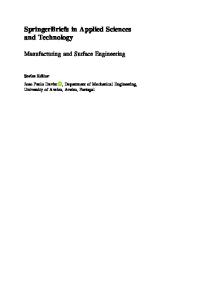Influence of Abrasive Water Jet Parameters on Steel Surface
- PDF / 1,568,547 Bytes
- 8 Pages / 593.972 x 792 pts Page_size
- 45 Downloads / 441 Views
https://doi.org/10.1007/s11837-020-04030-w Ó 2020 The Minerals, Metals & Materials Society
ADVANCES IN SURFACE ENGINEERING
Influence of Abrasive Water Jet Parameters on Steel Surface RUI GUO,1,2 CUNLONG ZHOU,2,3 and SHENGNAN YUAN2 1.—School of Transportation and Logistics, Taiyuan University of Science and Technology, Taiyuan 030024, Shanxi, China. 2.—Shanxi Provincial Key Laboratory of Metallurgical Device Design Theory and Technology, Taiyuan University of Science and Technology, Taiyuan 030024, Shanxi, China. 3.—e-mail: [email protected]
Descaling is a recent application of abrasive water jet machining. Several parameters can affect the steel surface and influence the descaling effect of abrasive water jet machining. The influence of the jet parameters has been experimentally studied, and the width of the surface morphology and roughness measured. The results show that the descaling width increases as the jet distance increases from 10 mm to 90 mm; the material removal at the cross section tends to be uniform. As the abrasive particle size is increased from 75 lm to 150 lm, the descaling width decreases whereas the material removal uniformity increases. Increasing the jet pressure from 30 MPa to 70 MPa increases the descaling width and material removal; the surface roughness improves to some extent, but the descaling uniformity decreases. As the jet angle is increased from 30° to 90°, the uniformity of the material removal decreases despite the increase in the descaling width.
INTRODUCTION Oxide scales are formed on the surface of steel during hot rolling, directly affecting the quality of stamping, coating, cold rolling, and other subsequent processes.1–4 Pickling is commonly used to remove these adherent layers.5 Despite its advantages, traditional acid pickling has several problems, of which the most serious is the great harm to environment and health of personnel caused by waste acid and acid fog.6 It is thus necessary to replace the traditional pickling line with an environmentally friendly descaling method. Some researchers have studied the application of abrasive water jet (AWJ) technology to cold rolling descaling.7,8 The abrasive water jet method, which relies on surface erosion damage caused by the highfrequency impact of high-speed particles on materials, can be used for machining all kinds of metal and nonmetallic materials.9 Compared with traditional acid descaling, abrasive water jet has the advantage of being environmentally safe because waste acid is not produced during this process. Abrasive water jet technology has been widely used in industrial applications such as cutting, drilling, and turning for substrate material removal.10–13 Other researchers have explored its use in the field of surface processing, such as
polishing and cleaning.14–16 The target machined by such processes is mostly made of a nonmetallic material, whereas research on machining of metallic targets by surface processing has received little attention. The parameters of abrasive jet processing can affect the machin
Data Loading...











